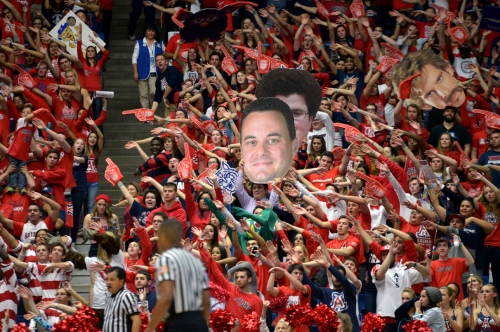Pac-12 Burning Questions: Where are the Fans?
Posted by Andrew Murawa on November 20th, 2015Arizona head coach Sean Miller called out UCLA this week for its poor attendance at games in Pauley Pavilion. But with only a very few exceptions, lack of attendance at basketball games has been a concern at schools up and down the conference. What kind of impact does this have on the overall health of a basketball program? And what can be done to fix it?
Adam Butler: There’s a lot of layers to this onion. There’s the #HotTake and the presumed “shade” thrown by Sean Miller. Reading between the lines we can also see that Steve Alford had a retort. That’s the fun stuff. I called it feed for the news cycle monster. But Drew’s question here doesn’t really address that fun matter (and it shouldn’t because it’s really not worth it). What I want to explore is attendance as a matter of conference health. As the question notes, the Pac-12 has seen declining average attendance in each of the past three seasons, with the abysmal 2011-12 season having the worst average attendance of any Pac-12 season (7,054 per game). Yet here we are, one season removed from three Sweet Sixteen teams and touting four ranked teams for the first time since the week of January 21, 2008. That’s five seasons of three or fewer ranked teams. And sure it’s early — and no doubt attendance is growing — but in this chicken-or-egg conversation I’m drawn to ask what attendance really means? Literally, attendance is the number of people that go to a game. But over time, attendance has come to be synonymous with popularity. And that’s simply inaccurate. It’s 2015 and we have page views and clicks and impressions. They just played a damn Pac-12 game in China! Games can be streamed on phones, tablets and desktops. Blogs like pachoops.com (wink face emoji) and this microsite can cover the sport at more intimate levels than national publishers that maybe, perhaps chop unique sports voices (cough, Grantland, cough). Miller’s comments aren’t wrong; he even noted that a screaming McKale is what we think of when we imagine college basketball. He’s absolutely right. But let’s not be so quick to dismiss the conference’s popularity because there aren’t as many butts in the seats.
Andrew Murawa: I’m going a different way than Adam. While yes there are good things going for the conference, there are also some serious problems, and its getting to the point where attendance issues may be exacerbating those problems rather than just merely reflecting them. Let’s recount some of the problems, some specific to basketball. This conference hasn’t won a national championship in men’s basketball in 20 years and have had only six teams earn a Final Four appearance in that same period. The league launched an optimistic cable network that has struggled to gain carriage. It plays a large percentage of games at times that make east coast sports fans sleepy. It also has an image problem that its competitors – the ACC, Big Ten, SEC and Big 12 – simply don’t have. And when a college basketball fan turns on a Pac-12 conference game and sees more empty seats than screaming fans, that’s not good for anybody. Sean Miller is right. One of the appeals of college sports and hoops in general is the atmosphere, the intensity, the fun. When you go to a UCLA game, for instance, and the place isn’t even half full and the student section is spending more time making balloon animals than cheering for the game, and when the rest of the fans don’t bother to get on their feet between tip-off and leave-early-to-beat-traffic time… that does not make for a great atmosphere. That type of thing can quickly devolve into a negative feedback loop. And all other things being equal, in the hyper-competitive environment of high-level recruiting, a sleepy in-arena atmosphere could make a difference. Alford has had no problems bringing in good recruiting classes thus far, but maybe the lack of buzz around that program has led a recruit or two to another campus.
There’s more, so much more, that can be said about the topic and we’ll probably touch on this throughout the year, but the second half of the question has to do with what can be done and that’s the harder nut to crack. The most direct plan to better crowds is a simple one-word directive: win. Arizona is the bellwether for the conference in terms of fan support, and it is no coincidence that the Wildcats have been to 29 of the last 31 NCAA Tournaments. Utah regularly gets plaudits these days for their fan support, but let’s not forget that when that program was in the dumps a few years back, the Huntsman Center spent many a winter’s night only half-full. The second challenge is to find a way – any way – to get students into the arena and engaged while they are there. Arizona State’s curtain of distraction is a silly little sideshow, but if it makes fans feel more involved in the game, it is incredibly worthwhile. Barring that, there’s the old story about Steve Fisher wandering the campus at San Diego State handing out tickets and begging students to show up – now the Aztecs have grown into one of the best student sections in the country. Solutions aren’t easy, but they’re out there. And in order to judge the overall health of a college basketball program, fan support and attendance numbers definitely need to be factored in.











































